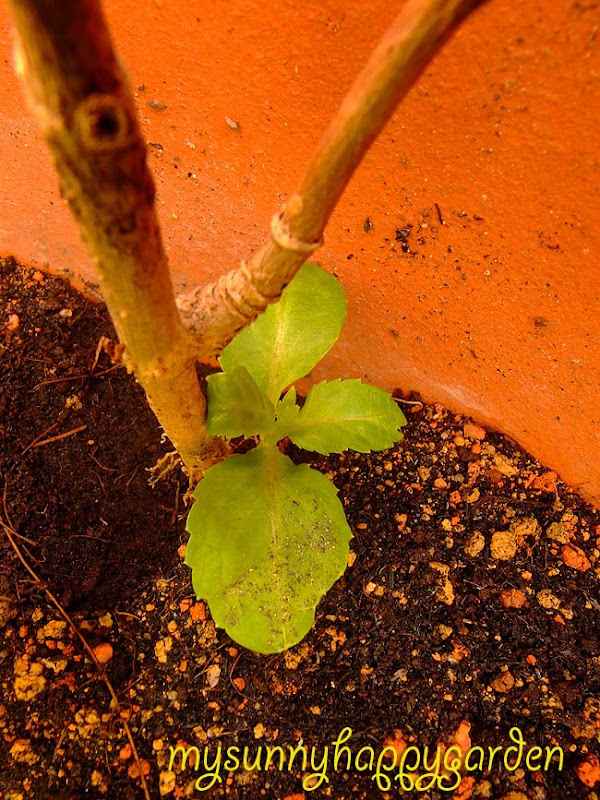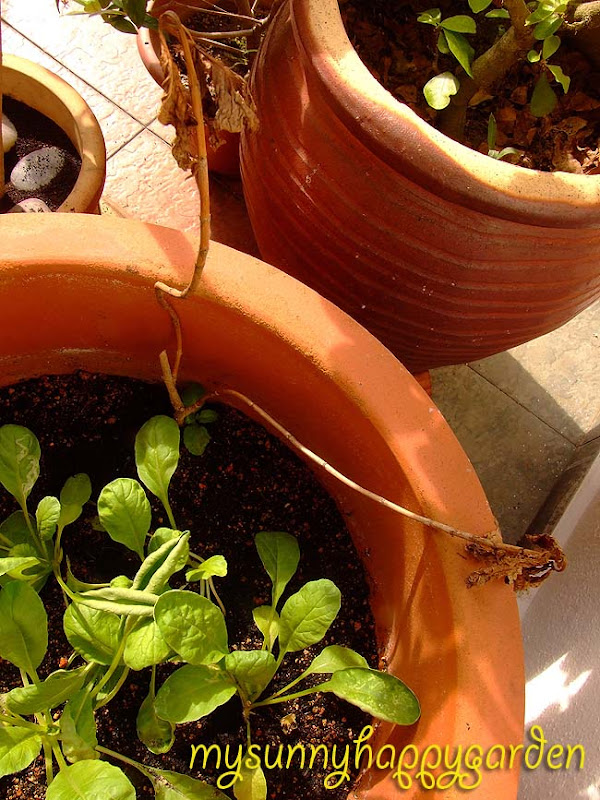When I need to use the pot to grow radishes, I pulled out the dried cutting and found roots forming. Instead of throwing the cutting, I moved it to the side of the pot. I was amazed to find new shoot growing from it recently. Yahoo!! I will have a Hydrangea plant now! I am taking great care of the plant to ensure that it will develop well.
My Hydrangea is currently sharing a pot with my radishes.
----------------------------------------------------------
Facts about Hydrangea:
- Soil
One of the coolest aspects of hydrangea is the way soil affects the blooms. In acid soil the blooms are blue. When it's more limey, the flowers are pink. In neutral soil, the bloom is white. You can literally change the color by adding lime to make blue flowers turn pink or aluminum sulfate to make them turn blue. This is caused by a color change of the flower pigments in the presence of aluminium ions.
Because hydrangeas thrive in rich, moist soils, adequate water and composting are a must. With good soil, annual additions of compost, and a good water retaining mulch, little more needs to be added to have healthy attractive plants.
However, if your climate or soil poses challenges, then it may be necessary to more aggressively amend your soil, and feed them, especially in the spring, with a high quality all-purpose (10-10-10) plant food. Use a single application of time-release fertilizer.
Drainage is important. As with most other plants, moist doesn't mean wet. Poor drainage can lead to sickly plants and eventual death. - Light
Partial shade is ideal, but they can take full sun as long as they have some protection from hot afternoon sun that can toast leaf edges. By the same token, too much shade can result in poor flowering.
An Eastern exposure next to a building or fence provides early morning sun that is vital to flower production, but allows afternoon shade that prevents stressing the plant and frying the foliage. - Water
Water often. If hydrangea is looking wilted, it's very thirsty. If it doesn't get enough water when flower heads are forming, you'll have fewer and smaller blooms later.
Install a drip irrigation system for your hydrangeas. With regular watering they will reward you with lush growth and beautiful flowers. - Pruning & Propagating
As long as they get enough water, hydrangeas are pretty hardy plants and tolerate a fair amount of neglect and untimely pruning. As such, it's a wonderful plant for the novice gardener. Be forewarned though: If you prune incorrectly at the wrong time or take the wrong cuts, you may easily end up with few flowers next year.
Hydrangeas, especially the macrophyllas, don't require pruning unless they get really big. Remove dead wood and spent blooms any time to maintain a tidy plant. Different varieties bloom on old wood (last year's growth) or new wood from the current season. It's important to check the plant tag or identify your variety before you start whacking away. If, for example, yours blooms on the tips of spring growth, do your pruning in the summer after blooming has occurred.
Prune or cut back spent blooms to force development of next year's buds. Thin canes on your plant to develop larger flower heads.
Hydrangeas are easy to root from stem or tip cuttings in late spring or early summer (May – June). Just take a 6-inch cutting of the plant, remove the leaves on the lower 3 inches and put it in a glass of water on a bright window sill. You can also dip the cut end into a rooting hormone. Place your cutting in damp vermiculite in a bright spot (like an Eastern exposure) to allow root formation. Once the cutting is rooted, you can keep it in a pot until ready to transplant outside.
When you plant your hydrangea starts depends on where you live. In areas where winters are temperate and the ground never really freezes you can plant your hydrangeas anytime, though fall and winter are best for fostering a strong root system to support the next seasons flowering. If your climate is colder, you'll need to plant in the spring ... for obvious reasons. Keep your young plant in out of the wind. Mulch it well to protect it through the winter.
(Source: Hydrangea Care)




6 comments:
Hydrangea is a great plant to grow. The flowers are extremely lovely. I wonder what is the colour ? Good Luck!
Glad you posted hydrangea. I have been tending mine for about a year already. I got a small one from a nursery. The hydrangea has grown big but no bloom yet. So, I have always observing how other gardeners are doing (here!). I notice some are placed in the hot sun and flowers??? But I still place mine in the shade. The plant is a really heavy drinker!
I hope you will find some carnivorous plant at Fauzi's stall later. And regarding herb plants, I love my rosemary and mint even though I have yet use them in my cooking he he... Oh that desert rose nursery, when I visited them again, they told me they don't have rm2 anymore. I was told they have been selling at rm5 ??? Remember to fix your price when you are there ok. The lady can be really sticky with price ;-)
Enjoy your radish plants and happy gardening!
Hi AutumnBelle, I think the flower of my Hydrangea will be blue coz I will feed the soil with goat dung. If not mistaken, it would turn the soil acidic, thus blue flower.
Hi Steph, Alright, I may pop by Fauzi's stall at Subang Parade this Sun after visiting Cetdem's Organic Day in SS2. Good quality Adenium plants are always priced very highly. That's why I prefer to grow them from seed although the success rate is quite low, where I am concerned. Ha ha... But I haven't got any seeds to grow those hybrid Adenium that produces blooms of several colours on one plant. That would cost a lot to purchase.
Oh, I am also growing some from stem cuttings too!
Do you know where to find a nusery that sell hydrangeas?
Hi..I just bought 3 hydrangeas, just try my luck because the last ones I planted years ago died by drought. Thanks God I found this blog..hopefully mine now will survive
Post a Comment